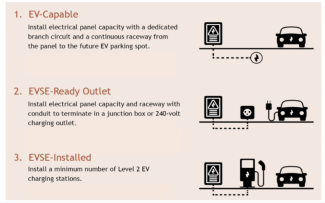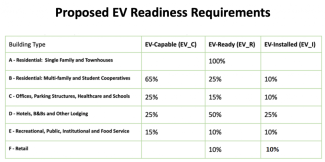Electric cars are coming. We need to be ready for them with adequate charging capacity, or else face costly infrastructure retrofits later.
by Elizabeth Harlow
In June, the Ann Arbor City Council unanimously voted to adopt the A2Zero Carbon Neutrality Plan, setting an ambitious strategy for reaching community-wide carbon neutrality by 2030. That’s the year that the UN IPCC’s expert scientists estimate is the point of no return, by which we could lose the opportunity to stop the worst ravages of the climate crisis. Supporting vehicle electrification is a key component of Ann Arbor’s plan and a critical element of necessary national and international action: the transportation sector is currently the greatest greenhouse gas contributor in the United States, responsible for 29% of emissions in 2017.
The implementation of electric vehicle charging infrastructure is lagging, however, so on December 21st, an official recommendation from the Ann Arbor City Planning Commission will be presented to the Mayor and City Council to help address that gap locally. A new proposed Electric Vehicle Readiness Ordinance will implement important changes to the parking rules in the City’s Unified Development Code, requiring electric vehicle changing facilities to be included in any new construction as part of the City’s Off-Street Parking requirements. The proposed ordinance aims to prepare Ann Arbor for expected EV growth and charging demand by mandating that a percentage of all new parking spaces in the City be either EV Capable (EV-C); EV Ready (EV-R); or EV Installed (EV-I).

Our all-electric vehicle future is on its way and arriving fairly quickly. EVs offer many appealing benefits to drivers beyond environmental conscientiousness: they’re quieter, cleaner, and boast a per mile operating cost that’s about half the expense of a traditional combustion engine. Current market projections from consulting firms MJ Bradley and McKinsey estimate that there may be anywhere from 600,000 to 1 million EVs on Michigan's roads by 2030, or 6% to 11% of the state’s vehicles. Even the more moderate estimate represents dramatic growth: today, EVs make up only 0.59% of registered vehicles in Michigan. The International Council on Clean Transportation estimates that the U.S. will need four times as many public charging stations in 2025 as it had in 2017 in order to meet market growth.
The City of Ann Arbor has recognized that it needs to ramp up its available charging infrastructure both to be prepared for and to encourage this needed transition to EVs. City planners partnered with the Ecology Center to assess the scale of the infrastructure needed over the next ten years, and the new ordinance grounds its requirements partly on our findings which forecast even faster EV growth here than across Michigan at large. The Ecology Center’s analysis, based on regional government data and the MJ Bradley study’s projections, estimate that Ann Arbor’s EV population will likely grow from a little over 1,500 to between 37,000 and 60,000 EV’s, making up 15% to 20% of vehicles registered in this area by the end of the decade. Based on these figures, the Ecology Center then used the Department of Energy’s EVI Pro-Lite tool to estimate the number of public and workplace charging stations that would be needed to support the expected growth in EVs.
Preparing parking spaces with conduit and wires at the time of new construction will save a lot of money that would go toward tearing into pavement and walls, and upgrading electrical systems, to install them in the future. A cost analysis for the Ann Arbor area estimated that retrofitting parking to add EV charging would cost twice as much per parking space as new construction. Other cities across the U.S., like Chicago, Denver, and San Francisco, have already adopted EV-friendly zoning ordinance amendments, based on similar concerns.
Site-specific requirements in the proposed ordinance vary based on the intended uses for the proposed new parking. For example, residential charging access is a critical factor for EV adoption; a battery that’s been fully charged overnight will get most people through a typical day. The proposed ordinance would thus require new multifamily housing developments to have 65% of parking spots EV-capable, 25% EV-ready, and 10% EV installed. The additional EV-R and EV-C spots make it easy to upgrade in the future, as the initial 10% of spots get filled up over time. Recreational and dining locations, where people are less likely to need to charge while parked for an hour or two, will have charging requirements for 15% capable, 10% ready, and 10% installed. These requirements will gradually but steadily build robust, needed capacity for EV charging as new buildings and parking areas are built within the City. If Ann Arbor had had this ordinance in place just a year ago, Ann Arbor would already have an additional 1,257 capable, 1,180 ready, and 362 installed, plug-in ready charging spaces.

The proposed EV Readiness Ordinance was developed by a Working Group of the City’s Energy Commission and fine-tuned with the assistance of the Planning Department staff and Ordinance Committee. “The team looked at every property zone classification in the Ann Arbor Unified Development Code and did a careful analysis for how humans arrive, stay and leave each property use type, paying particular attention to how dwell time can be incorporated/integrated into opportunity for charging one’s EV,” says Energy Commission and EV Readiness Working Group member Carlene Colvin-Garcia. “We used this analysis to determine what percentage of the required parking spaces for a given site should be equipped with EV charging infrastructure.”
The proposed ordinance also includes language officially encouraging the use of renewable energy for powering the charging stations to maximize environmental and financial benefits. The EV Readiness Working Group came to a unanimous conclusion that this recommendation was more appropriate than a mandate for multiple reasons, including the likely illegality of a renewable energy mandate under state law, problems with non-compliance enforcement, and redundancy with the first plank of the A2Zero Carbon Neutrality Plan, which already calls for a shift to 100% renewable energy for City residents by 2030.
This ordinance can also help deliver a more equitable and swift EV transition than would otherwise occur. Studies show, unsurprisingly, that increased charging station availability encourages EV adoption: if you can’t plug in your car at your apartment at night or your workplace during the day, it’s much harder to choose electric, even if you're otherwise eager to. This ordinance will make EV ownership more accessible for renters, not just homeowners. Rental property owners won’t lose out in the long run, either, by futureproofing their buildings with a currently unique amenity that offers lease negotiating power in the short term as well. The requirements also enhance job opportunities for local construction trade workers.
The proposed City EV Readiness ordinance is a win-win for Ann Arbor’s climate-conscious and cost-conscious citizens alike. The City will still need to take additional steps to ensure adequate charging infrastructure for existing parking, but for new construction it's a no-brainer.
Charles Griffith, the Ecology Center Climate and Energy Program Director who led the Ecology Center’s work on the ordinance puts it this way: “The bottom line is that Ann Arbor needs this ordinance if it has any chance of meeting its carbon neutrality goals and expanding EV access to all its residents. Without it, replacing petroleum-powered cars with cleaner electric ones will be much harder, more expensive, and less equitable.”


